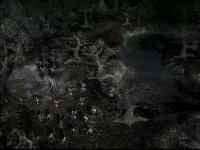
After reading the novels and then watching the films, I always wanted to command the armies of Middle-earth. My first chance came when EA released The Lord of the Rings: The Battle for Middle-earth, however they didn't release a demo and the game received so-so reviews, so I decided to pass.
Later on they released the sequel to the PC, and ultimately the Xbox 360, and this time they did release a demo, which I decided to try. The PC demo for The Lord of the Rings: The Battle for Middle-earth II was simple yet enjoyable and showed a lot of potential, and the game also received very strong reviews across the board, so I decided to ask for it as a gift for my birthday. That was in early October.
While I got my copy of The Lord of the Rings: The Battle for Middle Earth II - Collector's Edition (the first collector's edition title I've ever purchased/gotten for the PC) in early October, it took me this long to finish it. Why? Well, I've always been very picky about my real time strategy titles, or more to the point, very picky about the interface of the game. With very rare exceptions, I've only ever liked Blizzard Entertainment's RTSes as they've been of the highest quality with the most polished interfaces for their time. After getting underway with The Lord of the Rings: The Battle for Middle-earth II, I started to notice all the flaws in the interface and this really started to hamper my experience to the point where I stopped playing. However after finishing the game and spending a good deal of time with it over the last several days, I think I may have been too hard on the game.
The Lord of the Rings: The Battle for Middle-earth II takes place parallel to The Lord of the Rings and chron
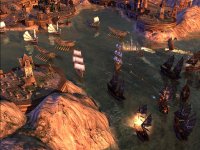 icles the war in the north of Middle-earth. While the armies of Mordor and Isengard assault the Men of the West, Sauron sends additional armies north to lay siege to the Elves, Dwarves, and other free peoples of that land. This war was mentioned in the book, however there was only a brief snippet of it in the Extended Edition of The Return of the King (when Legolas tells Gimli that he fears war is marching on the borders of his dwarven kin). So, one of the most exciting things about The Lord of the Rings: The Battle for Middle-earth II is simply being able to see locations that you've read about, but have never really seen.
icles the war in the north of Middle-earth. While the armies of Mordor and Isengard assault the Men of the West, Sauron sends additional armies north to lay siege to the Elves, Dwarves, and other free peoples of that land. This war was mentioned in the book, however there was only a brief snippet of it in the Extended Edition of The Return of the King (when Legolas tells Gimli that he fears war is marching on the borders of his dwarven kin). So, one of the most exciting things about The Lord of the Rings: The Battle for Middle-earth II is simply being able to see locations that you've read about, but have never really seen.The Single Player game is broken down as follows: You have a tutorial where you play as the Men of the West in the White Mountains that teaches you the very bare-bone basics. There is then a Good Campaign where you play as the Elves and Dwarves and a "what if" Evil Campaign where you play as the Goblins and Mordor. The last faction, Isengard, makes a very brief appearance in the Evil Campaign, however they are not playable in the Campaigns. There is also a standard Skirmish mode and the War of the Ring mode which I'll type about later.
Now, on to my major gripe: The interface. This game must of had a target release date of 1998. Why? Because it has the same styled interface as Starcraft. The units in The Lord of the Rings: The Battle for Middle-earth II have a good number of special abilities to choose fro
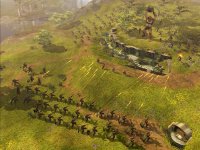 m, including the Hero units. I'd like to tell you how great this special ability is, or how unbalanced that special ability is, but I honestly wouldn't know. Why? Because battles are so large and the controls so antiquated that micromanagement is a nightmare.
m, including the Hero units. I'd like to tell you how great this special ability is, or how unbalanced that special ability is, but I honestly wouldn't know. Why? Because battles are so large and the controls so antiquated that micromanagement is a nightmare.If you have a bunch of different unit types grouped together, you can not "tab" between them to access different special abilities quickly, you're forced to put different units on different number keys. However if you group more than one battalion or horde to a number key and use the special ability, only one battalion will do so while the others continue to bumble around normally. There's also no way to select an individual Hero unit quickly other than clicking on their portrait at the bottom of the screen.
What does this all mean? It means that The Lord of the Rings: The Battle for Middle-earth II is extremely heavy on tactics, but low on strategy. Against the AI at any rate, the primary strategy is simply hucking masses of units at them, possibly holding your regular units at bay while siege units punch a whole in walls or defences. Hero units also just become damage sponges instead of heavily turning the tide of battle with special abilities.
Having learned to live or die by micromanagement with Warcraft III: The Frozen Throne a few years ago, this
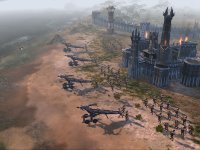 was, at first, simply appalling to me. The more I played the more frustrated I got and so after forcing myself to finish the Good Campaign and just begin the Evil Campaign, I stopped. I couldn't believe that such a slick and high production value title could stumble up on such a critical component; and I do mean a slick title.
was, at first, simply appalling to me. The more I played the more frustrated I got and so after forcing myself to finish the Good Campaign and just begin the Evil Campaign, I stopped. I couldn't believe that such a slick and high production value title could stumble up on such a critical component; and I do mean a slick title.The Lord of the Rings: The Battle for Middle-earth II is beautiful. I'm playing on the High graphic settings, and everything, and I mean everything, is so detailed that it's all a joy to look at. Every unit, every building, every landscape has had so much attention paid to the models and animations, and the water effects! The game has to be seen to be believed. Audio wise, all the effects and music are taken from the films or else engineered in the same style. With the exception of certain Heroes being voice-acted by someone other than their film actor, it all fits and flows together. The Collector's Edition also comes with an interesting DVD that goes into the making of the game, contains all the cinematics, art samples, the soundtrack, etc. And then there's War of the Ring mode.
War of the Ring is a lot like playing Risk. You have a map of Middle-earth that's divided up into territories and you start with a small army and three Heroes in your territory and
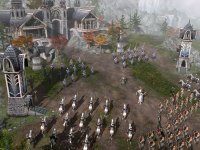 your enemy(ies) and ally(ies) start in their's. You then take turns moving along the board claiming territories, building basic structures to train and upgrade troops and recruit Heroes, and generally try to defeat your opponent(s). Battles can be auto-resolved on the map based on troop strength, or you can actually do an RTS battle. While this is cool as you can actually see an RTS map with Minas Tirith, Isengard, Helm's Deep, etc., these near-skirmish like battles can take a while, meaning you could be playing a War of the Ring game for over 12 hours minimum. Yes, minimum. For this reason, unless you have that much free time on your hands, I recommend using the auto-resolve option. Generally, I found a War of the Ring game to take about 2 to 4 hours and with the different game modes available (claim all territories, claim X amount of territories, claim your opponent's capital), there was enough variety to keep things fresh and fun.
your enemy(ies) and ally(ies) start in their's. You then take turns moving along the board claiming territories, building basic structures to train and upgrade troops and recruit Heroes, and generally try to defeat your opponent(s). Battles can be auto-resolved on the map based on troop strength, or you can actually do an RTS battle. While this is cool as you can actually see an RTS map with Minas Tirith, Isengard, Helm's Deep, etc., these near-skirmish like battles can take a while, meaning you could be playing a War of the Ring game for over 12 hours minimum. Yes, minimum. For this reason, unless you have that much free time on your hands, I recommend using the auto-resolve option. Generally, I found a War of the Ring game to take about 2 to 4 hours and with the different game modes available (claim all territories, claim X amount of territories, claim your opponent's capital), there was enough variety to keep things fresh and fun.Several days ago I determined to finish the game once and for all and just get it off my play list, however once I started playing through the Evil Campaign again, I found that I was enjoying myself. Sure, I was just hucking units at one another, but it was fun to quickly build a town, train hordes and march them off in formation, watch cavalry run over infantry, and see Trolls knock soldiers into mid-air. While the Good Campaign was also a bit boring story wise, I found the Evil Campaign to be a little more fun in that regard. So, instead of focusing on micromanaging battles, I had turned to managing unit production and base management, and though it's no Warcraft III: The Frozen Throne, it was fun in it's simplicity, and in the end, fun is what mainly matters to me in games these days; my competitive tournament days are behind me.
I've tinkered with Skirmish mode and the Medium AI seems to put up a good but not impossible fight. There's
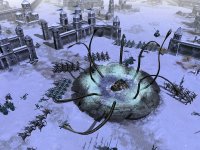 a large variety of maps to choose from, as well as neutral buildings (including Ship Yards) that you can claim to enhance your forces. In all modes, you also get Powers for your faction. You can summon Eagles as the Elves to attack your enemies, use a group Healing spell, or even summon a special Hero or reinforcements. The same goes for the forces of Evil. It's great fun to see a Watcher of the Water erupt from the ground and start smacking everyone around and dragging individual units to it's mouth. Again, a lot of visual detail and polish. Skirmish mode itself is something I need to experience more of, but it does have potential.
a large variety of maps to choose from, as well as neutral buildings (including Ship Yards) that you can claim to enhance your forces. In all modes, you also get Powers for your faction. You can summon Eagles as the Elves to attack your enemies, use a group Healing spell, or even summon a special Hero or reinforcements. The same goes for the forces of Evil. It's great fun to see a Watcher of the Water erupt from the ground and start smacking everyone around and dragging individual units to it's mouth. Again, a lot of visual detail and polish. Skirmish mode itself is something I need to experience more of, but it does have potential.You can also create your own custom Heroes to use in both Skirmish and War of the Ring, however I didn't tinker with this and just used the game's default Heroes.
So, in the end, what's the verdict? I've flip-flopped with my impressions of The Lord of the Rings: The Battle for Middle-earth II. On the one hand you have an extremely high production value title, but on the other you have an antiquated control scheme. However I now believe that the game was designed with tactics and less so strategy in mind. I will say one thing, it does present a bit more realistic view of the chaos of medieval style battles, and the battles and sieges of this game can certainly feature a huge number of units.
I'd say if you're interested in commanding the armies of Middle-earth in massive battles, download the demo for either the PC or Xbox 360 and see what you think. Regardless, I'd wait for a price drop before dropping $50.00 plus on the title. The Lord of the Rings: The Battle for Middle-earth II is a fun game with some really enjoyable moments, however at present I don't feel it's worth the price of admission. Once the price does drop to, say, $30.00-ish, go have some fun knocking soldiers into the air. You'll laugh your ass off.



No comments:
Post a Comment